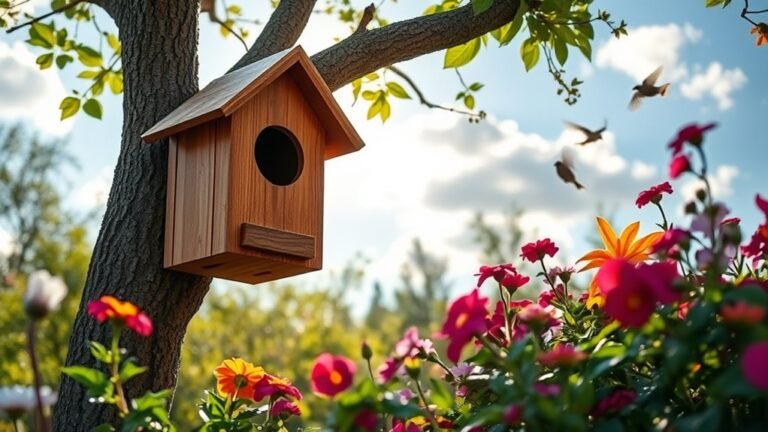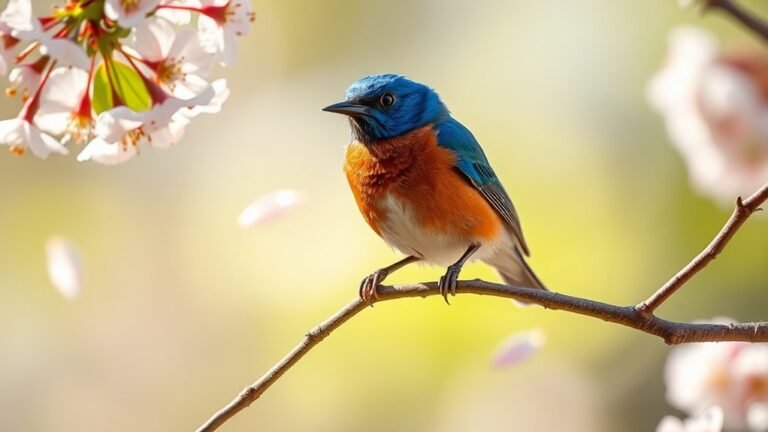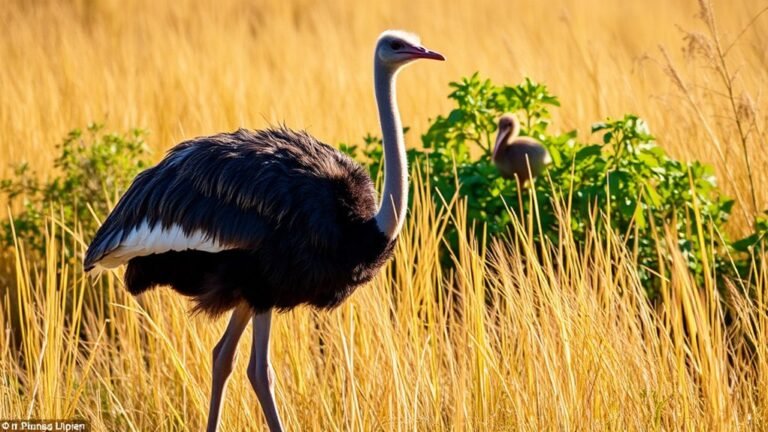Small Birds That Fly Like Bats at Dusk: Crepuscular Flyers
When you watch crepuscular flyers at dusk, you see small birds, such as the Common Nighthawk and Barn Swallow, flying like bats. They have unique flight patterns and hunt for insects in low light. This behavior helps them catch food effectively. Learning about these birds and their roles in the ecosystem raises interesting questions about how they survive and the challenges they encounter. Understanding their adaptations provides insight into their lives and how they navigate their environments.
Key Takeaways
Crepuscular birds, like the Common Nighthawk and Barn Swallow, are active during twilight hours. They hunt in low light, taking advantage of the rise in insects at dusk. These birds have developed adaptations such as silent flight and twilight camouflage, which help them evade predators.
Urbanization presents challenges for these birds, leading to habitat loss and increased light pollution. This affects their natural behaviors and survival.
To observe these twilight flyers, plan outings at dawn and dusk. Look for them in suitable habitats like wetlands and forests. You'll enjoy the unique experience of watching these birds soar through the evening sky.
Understanding Crepuscular Behavior in Birds
Crepuscular birds are active during dawn and dusk. They take advantage of lower light conditions to find food and avoid predators. This behavior helps them hunt insects and other sources of food.
You might see species like hummingbirds and certain warblers during these times. Their eyes adapt well to low light, which makes foraging easier.
The Importance of Dusk for Foraging
Dusk is important for crepuscular birds as they forage for food. During twilight, the light decreases, creating ideal conditions for their hunting. This low-light setting helps them hide from both their prey and predators.
As day turns to night, nocturnal insects become more active and seek shelter, giving these birds a good opportunity to find food. Their eyes are adapted to see well in dim light, which improves their ability to locate food accurately.
Furthermore, dusk encourages social interactions among these birds, which can enhance their foraging success.
Understanding how dusk impacts their foraging helps us appreciate the behaviors of these remarkable birds.
Key Adaptations of Crepuscular Flyers
Crepuscular flyers have special traits that help them survive during dawn and dusk. They've better vision, which allows them to see well in low light. This ability helps them find food easily.
Their behavior also supports survival; they actively forage and communicate with others during these times. Their flight patterns are similar to bats, which allows them to move quickly among trees and avoid predators.
Many species also use unique calls that carry well in low light, helping them connect with others. These traits show how well crepuscular flyers adapt to their changing environments.
Common Small Birds That Fly at Dusk
What small birds can you see flying in the dim light of dusk? As night approaches, birds become more active.
Here are three common small birds you might spot at this time:
- Common Nighthawk – This bird is known for its unique call. It catches insects while flying, making it a frequent sight at dusk.
- Barn Swallow – These birds are fast and agile. They're often seen zooming around as they search for food.
- Chipping Sparrow – These birds are quieter and often nest in shrubs as darkness falls.
Enjoy watching these creatures as they move through the evening sky!
The Aerial Acrobatics of Twilight Flyers
As twilight falls, some small birds put on an impressive aerial show. These "twilight flyers" display great agility and precision in their flight. Their wing structure allows them to make quick turns and sharp dives, which is vital in low light.
These birds hunt and interact socially during twilight, adapting to the challenges of dim conditions where competition for food increases. As they zip through the sky, their wingbeats create a pleasing rhythm, showcasing both their elegance and natural skills.
Watching these aerial displays helps us appreciate their important role in the ecosystem and highlights the balance of nature as darkness approaches.
How Crepuscular Birds Avoid Predators
Crepuscular birds use effective strategies to avoid predators in low-light conditions. Their survival depends on several key techniques:
- Twilight camouflage: Their feathers match the shadows of their environment, making them hard for predators to see.
- Silent flight: Their wings are structured to minimize noise, helping them move quietly and stay unnoticed by threats nearby.
- Behavioral adaptations: They forage and nest in safe areas during twilight, reducing their chances of encountering active predators at that time.
These strategies show how crepuscular birds successfully evade danger in dim light.
Understanding these behaviors helps us appreciate the skills of these remarkable birds as they thrive in their habitats.
The Role of Twilight in the Ecosystem
Twilight is important in the ecosystem. This time between day and night allows various species to interact. Birds, insects, and other creatures benefit from this period.
In low light, crepuscular flyers catch insects in the sky. Their actions help maintain balance in nature. Species adapt as they share resources, ensuring no group overpopulates or diminishes.
If twilight interactions stopped, food webs would face disruption, threatening specific populations. Recognizing twilight's role helps us understand how different species connect and supports the need to protect these ecosystems.
Emphasizing the value of twilight can deepen our appreciation for nature's relationships.
Comparison With Nocturnal Birds
Crepuscular birds are active during twilight hours, while nocturnal birds hunt in total darkness. These two groups have important differences due to their unique lifestyles. Here are three main points:
- Vision: Nocturnal birds have eyes with many rod cells to see well in low light. Crepuscular birds have a mix of rod and cone cells, allowing them to see during dusk and dawn.
- Behavior: Crepuscular birds forage in various habitats, using available light for guidance. In contrast, nocturnal birds hunt quietly and stealthily to avoid detection.
- Feeding: Nocturnal birds may use echolocation to find their food. Crepuscular birds often take advantage of dusk to catch insects that are more active during this time.
Understanding these differences helps us appreciate how each group of birds has adapted to their environment.
The Impact of Urbanization on Crepuscular Birds
As cities grow, they significantly impact crepuscular birds. Habitat loss disrupts their flight paths and decreases nesting options, making it harder for these birds to survive.
Light pollution changes their natural behaviors, affecting how they find food and reproduce. Urban heat and pesticide use cause insect populations to fluctuate, which alters food availability. These changes often lead to declines in crepuscular bird populations.
Birds also change their behaviors in response to urban settings. They may establish territories differently and vocalize less.
Balancing urban development with the needs of these birds presents challenges. By understanding these impacts, we can better appreciate urban ecosystems and the wildlife that inhabit them.
Migration Patterns of Dusk Flyers
Understanding the migration patterns of dusk flyers shows how they adapt to their unique lifestyles. These birds employ specific strategies to thrive during seasonal changes.
Here are the main points:
- Timing of Migration: Dusk flyers migrate during twilight. This helps them avoid daytime predators and use energy efficiently.
- Migration Routes: Their routes depend on food availability and breeding grounds. They change their paths as environmental conditions shift.
- Adaptation to Climates: Dusk flyers alter their migration based on temperature changes. This helps them stay in suitable habitats all year round.
These adaptations highlight their strength and importance in maintaining ecological balance. Dusk flyers play a vital role in the interconnected web of nature.
Conservation Efforts for Crepuscular Species
The conservation of crepuscular species is essential for a stable ecosystem. Protecting their habitats ensures they've safe environments for feeding and nesting.
Reducing urban development and agricultural practices limits habitat fragmentation, supporting healthier populations. Monitoring species is critical; it helps track population changes and spot threats.
You can participate in citizen science projects to collect data and raise local awareness.
Working with conservation organizations provides resources and connects you with others who share the goal of protecting these remarkable creatures.
Observing Crepuscular Birds: Best Practices
Observing crepuscular birds can be a rewarding experience with some careful preparation.
Follow these three best practices to improve your chances of success:
- Choose the Right Time: Look for birds at dawn and dusk, as they're most active during these hours.
- Select a Suitable Location: Visit diverse environments, like wetlands or forests, where these birds gather.
- Use Appropriate Gear: Bring binoculars and a camera that works well in low light to capture fleeting moments.
With these tips, you can enjoy a fulfilling birdwatching adventure.
Happy observing!
Fascinating Facts About Twilight Flyers
Twilight is a special time for certain birds known as twilight flyers. These birds have unique adaptations that help them thrive in low light. Their eyes are often larger compared to their bodies, which improves their vision during dusk. This allows them to locate food as the light fades.
Many twilight flyers also gather in flocks during this time. They communicate using various calls, making their gatherings lively and social.
Observing these birds can enhance your understanding of nature and provide enjoyment. Watching them in action shows the beauty of life as day transitions to night.
Frequently Asked Questions
Do Crepuscular Birds Have Specific Mating Seasons?
Yes, crepuscular birds have specific mating seasons. Their mating behaviors and breeding patterns are linked to seasonal changes. You will see more activity during these times. This helps them increase their chances for successful reproduction and survival.
How Do Weather Conditions Affect Crepuscular Bird Activity?
Weather conditions significantly impact crepuscular bird activity. Temperature changes can influence their feeding habits. For example, warmer temperatures may increase their food search. Conversely, colder temperatures may cause them to be less active.
High wind speeds can discourage these birds from flying. They may choose to stay grounded if the winds are strong. This change in behavior can affect their activity levels during twilight hours.
What Sounds Do Crepuscular Birds Make at Dusk?
Crepuscular birds sing at dusk, creating unique calls that differ from the morning songs. These birds are adapted to nighttime activity, allowing them to make softer, rhythmic sounds. This helps them communicate effectively while blending into the dim light of twilight. Listening to these birds can provide a soothing and calming experience as day turns into night.
Are Crepuscular Birds Found in All Habitats?
Crepuscular birds live in many habitats. They can be found in forests, wetlands, and grasslands. These birds adapt their migration patterns to fit different environments. This shows their ability to thrive in various regions. Their flexibility helps them survive and flourish across different landscapes.
What Threats Do Crepuscular Birds Face Beyond Habitat Loss?
Crepuscular birds face several threats that go beyond habitat loss. One major threat is increased predation risk because they are most active during dawn and dusk. This timing makes them more vulnerable to predators. Another significant challenge is food scarcity during these critical foraging periods. As a result, these factors affect their survival and lead to declining populations. Addressing these issues is important for the conservation of crepuscular bird species.

Ava is a bird enthusiast and nature lover who has spent countless hours observing and learning about the fascinating world of birds. With a passion for sharing her knowledge and inspiring others to appreciate the beauty of birds, Ava writes about her experiences and insights on avianadmirer.com.







